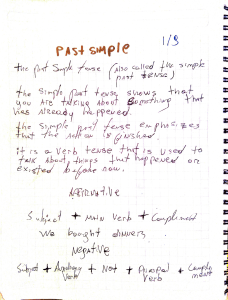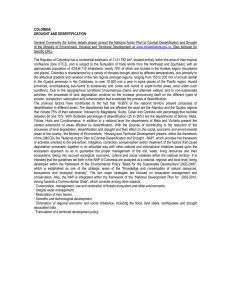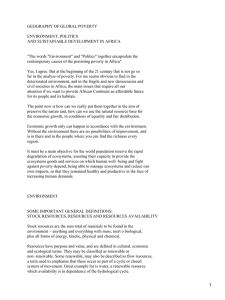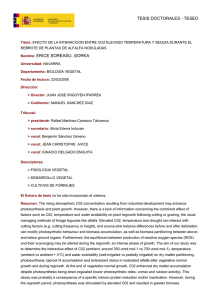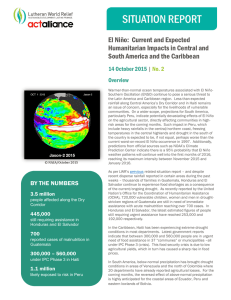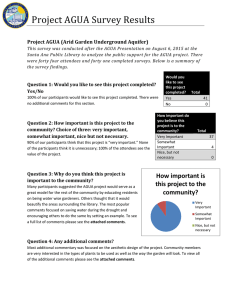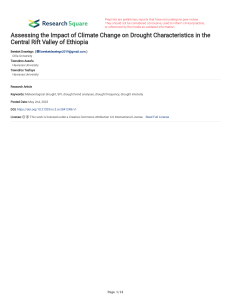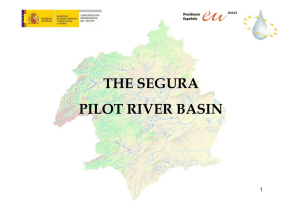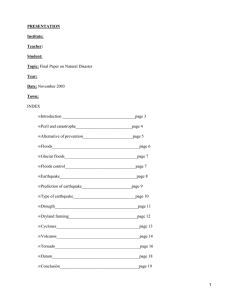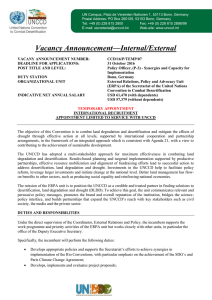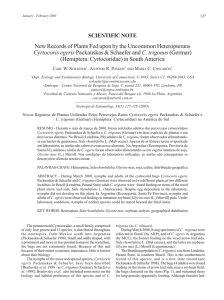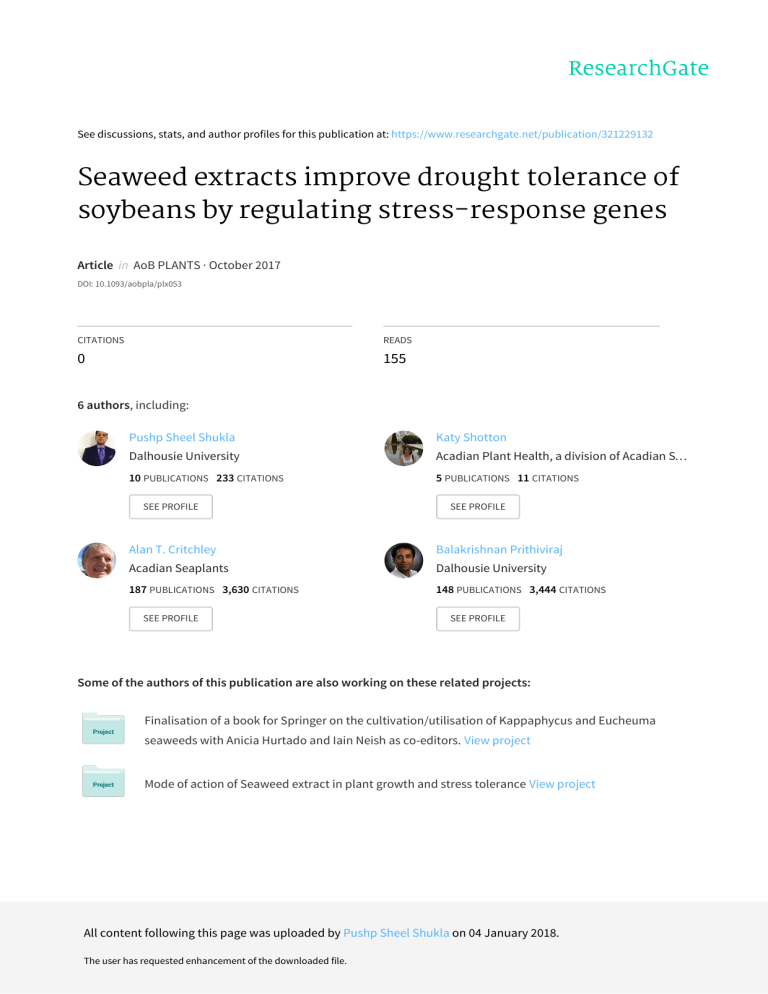
See discussions, stats, and author profiles for this publication at: https://www.researchgate.net/publication/321229132 Seaweed extracts improve drought tolerance of soybeans by regulating stress-response genes Article in AoB PLANTS · October 2017 DOI: 10.1093/aobpla/plx053 CITATIONS READS 0 155 6 authors, including: Pushp Sheel Shukla Katy Shotton Dalhousie University Acadian Plant Health, a division of Acadian S… 10 PUBLICATIONS 233 CITATIONS 5 PUBLICATIONS 11 CITATIONS SEE PROFILE SEE PROFILE Alan T. Critchley Balakrishnan Prithiviraj Acadian Seaplants Dalhousie University 187 PUBLICATIONS 3,630 CITATIONS 148 PUBLICATIONS 3,444 CITATIONS SEE PROFILE SEE PROFILE Some of the authors of this publication are also working on these related projects: Finalisation of a book for Springer on the cultivation/utilisation of Kappaphycus and Eucheuma seaweeds with Anicia Hurtado and Iain Neish as co-editors. View project Mode of action of Seaweed extract in plant growth and stress tolerance View project All content following this page was uploaded by Pushp Sheel Shukla on 04 January 2018. The user has requested enhancement of the downloaded file. Short Communication Seaweed extract improve drought tolerance of soybean by regulating stress-response genes Pushp S. Shukla1, Katy Shotton2, Erin Norman2, Will Neily2, Alan T. Critchley2 and Balakrishnan Prithiviraj*1 Marine Bio-Products Research Laboratory, Department of Plant, Food and Environmental Sciences, Faculty of Agriculture, Dalhousie University, Truro, Nova Scotia, Canada. 2 Research and Development, Acadian Seaplants Limited, Dartmouth, Nova Scotia, Canada. 1 Received: 15 March 2017 Editorial decision: 18 September 2017 Accepted: 4 October 2017 Published: 11 October 2017 Associate Editor: Wen-Hao Zhang Citation: Shukla PS, Shotton K, Norman E, Neily W, Critchley AT and Prithiviraj B. 2017. Seaweed extract improve drought tolerance of soybean by regulating stress-response genes. AoB PLANTS 10: plx051; doi: 10.1093/aobpla/plx051 Abstract. There is an increasing global concern about the availability of water for agricultural use. Drought stress negatively impacts plant physiology and crop productivity. Soybean (Glycine max) is one of the important oilseed crops, and its productivity is often reduced by drought. In this study, a commercial extract of Ascophyllum nodosum (ANE) was evaluated for its potential to alleviate drought stress in soybean. The aim of this study was to determine the effects of ANE on the response of soybean plants to drought stress by monitoring stomatal conductance, relative leaf water content, antioxidant activity and expression of stress-responsive genes. Plants treated with ANE had higher relative water content and higher stomatal conductance under drought stress. During early recovery in the post-drought phase, ANE treated plants had significantly higher stomatal conductance. The antioxidant activity was also found higher in the plants treated with ANE. In addition, ANE-treatment led to changes in the expression of stress-responsive genes: GmCYP707A1a, GmCYP707A3b, GmRD22, GmRD20, GmDREB1B, GmERD1, GmNFYA3, FIB1a, GmPIP1b, GmGST, GmBIP and GmTp55. Taken together, these results suggest that applications of ANE improve the drought tolerance of soybean by changing physiology and gene expression. Keywords: conductance. Ascophyllum nodosum; commercial extract; drought stress; plant biostimulant; soybean; stomatal Introduction Abiotic stresses such as salinity, drought and temperature (heat and cold) have negative effects on plant productivity (Agarwal et al. 2013). Amongst these abiotic stresses, drought is one of the major factors limiting crop productivity in many parts of the world (Farooq et al. 2009). As a means of natural adaptation, plants have been equipped with a wide spectrum of physiological responses to mitigate the damaging effects of drought stress. The response of plants to such stressors is polygenic, complex and dynamic processes (Chaves et al. 2003). These adaptations include expression of stress-related genes, induction of biochemical responses, maintenance of root growth and water uptake, and reduced leaf area (Seki et al. 2007; Krasensky and Jonak 2012). It is well known that drought stress induces the accumulation of abscisic acid (ABA) which regulates stomatal closure thereby reducing photosynthetic activity (Chaves et al. 2009). *Corresponding author’s e-mail address: [email protected] © The Author(s) 2017. Published by Oxford University Press on behalf of the Annals of Botany Company. This is an Open Access article distributed under the terms of the Creative Commons Attribution License (http://creativecommons.org/ licenses/by/4.0/), which permits unrestricted reuse, distribution, and reproduction in any medium, provided the original work is properly cited. AoB PLANTS https://academic.oup.com/aobpla Downloaded from https://academic.oup.com/aobpla/article-abstract/10/1/plx051/4434644 by guest on 04 January 2018 © The Author(s) 2017 1 Shukla et al. − Ascophyllum nodosum extract mitigates drought tolerance in Glycine max ABA-mediated stomatal closure is one of the first responses to drought stress (Hetherington and Woodward 2003). Although guard cells loose turgor as a result of a direct loss of water, stomatal closure, in response to dehydration, is always an active, energydependent process (Hetherington and Woodward 2003). Stomatal closure results in reduction of stomatal conductance and CO2 availability, which directly reduces rates of photosynthesis (Chaves et al. 2003). The response is accompanied by an increase in leaf temperature (Jones 1999). If leaf temperature reaches a threshold, it often leads to irreversible leaf tissue damage. Hence, leaf temperature can be used as an indicator of plant stress (Jones 1999; Jones et al. 2009). Due to the complex metabolic pathways involved in drought tolerance, there has been limited success in generating drought-tolerant crop varieties by means of genetic engineering. Another approach to improve drought tolerance in plants is the use of plant biostimulants which are gaining major market acceptance (Khan et al. 2009; Jithesh et al. 2012). One category of product accepted as a biostimulant is seaweed extracts. Extracts of brown seaweeds are increasingly used in agricultural and horticultural crop production (Khan et al. 2009; du Jardin 2015; Battacharyya et al. 2015; Tandon and Dubey 2015). Soil or leaf applications of seaweed extract increase chlorophyll content, improve photosynthesis and nutrient uptake (Blunden et al. 1997), whilst also increasing water retention capacity and generally ameliorating biotic and abiotic stresses (Zhang and Schmidt 1999; Sangha et al. 2010; Subramanian et al. 2011). Studies have shown the positive effects of commercial extract of Ascophyllum nodosum on plants’ tolerance to stresses (Neily et al. 2010; Spann and Little 2011; Wally et al. 2013; Martynenko et al. 2016). However, the mode of action of seaweed extract in improving stress tolerance is not fully understood. Soybean (Glycine max) is one of the major oil-seed crops in the world and has a great economic and social value (Manavalan et al. 2009). Drought stress is perhaps the major constraint to the production and yield of this crop. In this study, we investigated the plausible mode of action of ANE in mitigating drought stress in soybean. Methods Plant growth and stress treatment Soybean (Glycine max), variety Savana was planted in ProMix BX (Premier Tech Horticulture, Canada) in 200seed trays, in a growth chamber with an 18/6 dark/light cycle with 400 µmol m−2 s spectral flux photons of photosynthetically active radiation (PAR) at 27 °C for 7 days. 2 AoB PLANTS https://academic.oup.com/aobpla Downloaded from https://academic.oup.com/aobpla/article-abstract/10/1/plx051/4434644 by guest on 04 January 2018 After germination, the plants were transplanted into 12 cm pots and placed in a Conviron® environmental chamber (Winnipeg, Canada) and grown for an additional 14 days, then the drought stress was initiated. The environmental chamber was set at 16:8 light/dark cycle, with 27 °C temperature, ~400 µmol m−2 s−1 PAR, 600 ppm CO2 and 60% relative humidity. Soybean plants were divided into two sets having 10 plants per set; twice weekly one set of the control plants were treated with a 100 mL solution of 0.5 g L–1 fertilizer per plant (20-8-20, Plant Products, Canada) and the other set, individual plants were treated with 0.5 g L–1 of the same fertilizer solution but with 7.0 mL L–1 ANE (Acadian®, Acadian Seaplants Limited, Dartmouth, Nova Scotia, Canada).Twenty-one days after planting, both the sets of plants were further treated with 1.0 g L–1 20-8-20 and 1.0 g L–1 20-8-20 plus 7.0 mL L–1 ANE, respectively, until the soil was completely saturated and excess liquid ran through the bottom of the pots (~300 mL). This equalized the soil moisture content for the onset of water stress. After this application, the plants were subjected to the drought stress by stopping irrigation. Measurements of different parameters and samples were taken at three time points related to three phases of stress, that is before stress (22 h after last treatment when the substrate was still wet), during stress (75 h after last treatment and recovery. In recovery phase, both the sets of plants were irrigated after 89 h after the last treatment and samples were collected 8 h after irrigation). For gene expression studies, the third set of trifoliate leaves were taken in triplicates from each treatment and directly frozen in liquid nitrogen to be stored at −80 °C. Determination of free-radical scavenging activity Free-radical scavenging activity was evaluated, as described by Kähkönen et al. (1999); briefly a 200 mg leaf sample was homogenized in 15 mL of 80% methanol and centrifuged for 15 min at 5000 rpm at 4 °C. Two hundred and fifty microliters of the methanolic extracts from each sample were added to 250 μL methanol and 500 μL of 1, 1-diphenyl-2-picrylhydrazyl (DPPH; 0.024 %). The reaction mixture was then incubated for 30 min in the dark conditions and absorbance was read at 515 nm. Trolox (6-hydroxy-2, 5, 7, 8-tetramethylchroman-2-carboxylic acid) was used as a positive control and the results were expressed as mmol Trolox equivalents g−1 dry weight (mmol TE g−1 DW). Determination of stomatal conductance Stomatal conductance was measured on the third leaf of each plant using a SC-1 porometer (Decagon, Pullman, Washington, DC) from each treatment at each of the different sampling points. © The Author(s) 2017 Shukla et al. − Ascophyllum nodosum extract mitigates drought tolerance in Glycine max Quantitative real-time PCR analysis of stress inducible genes Total RNA was extracted from the control and ANEtreated soybean plants during different stages of the drought treatment using the RNAeasy kit (Qiagen), following the manufacturer’s protocol. The quantity and purity of total RNA was analysed using a NanoDrop 2000 spectrophotometer (Thermo Scientific, USA). The total RNA was stored at −80 °C, and used for qPCR expression analysis. 2.0 μg of RNA was treated with DNase I (Promega, USA) followed by first strand cDNA synthesis using a RevertAid cDNA synthesis kit (Thermo Scientific, USA). Real-time PCR was completed using cDNA by Step One™ Real-Time PCR system (Applied Biosystems). Tubulin was used as an internal control gene. A list of the primers used in this study is presented in Table 1. The specificity of PCR amplification was validated at the end of the PCR cycles, by melt-curve analysis. Each reaction was replicated three times and the relative-fold expression was determined using 2 −∆∆CT method as described by Livak and Schmittgen (2001). Statistical analysis Results are expressed as mean ± standard deviation (SD). Each experiment was replicated three times and was conducted in triplicate. The data were analysed using ANOVA, with a P-value of ≤ 0.05 using the ‘Proc. mixed procedure’, of the SAS Institute, Inc., Software version 9.3 (SAS Institute, Inc., Cary, NC). When significant effects of treatments were found, a multiple means comparison was carried out using Tukey’s analysis, with a 95 % confidence interval and α = 0.05 to differentiate treatment means. Results and Discussion ANE improves growth of soybean under drought stress Applications of ANE reduced the degree of wilting of soybean grown under the influences of imposed drought conditions (Fig. 1). The plants treated with ANE had demonstrably better adaptability to recover from drought conditions. ANE treated plants had a 50 % higher water content when exposed to drought conditions, as compared to the control plants (data not shown). Effect of application of ANE on stomatal conductance and free-radical scavenging activity in drought-stressed soybean ANE treatment significantly improved the stomatal conductance of soybean plants under drought conditions (Fig. 2a); the stomatal conductance of ANE treated plants was 46 % greater than that of control plants (Fig. AoB PLANTS https://academic.oup.com/aobpla Downloaded from https://academic.oup.com/aobpla/article-abstract/10/1/plx051/4434644 by guest on 04 January 2018 2a). After rehydration, stomatal conductance of ANE treated plants was 46 % higher than control plants (Fig. 2a). Martynenko et al. (2016) showed that ANE from A. nodosum improved the drought tolerance of soybean plants by regulation of leaf temperature and turgor. During water scarcity, plants reduce stomatal conductance, and consequently causing an increase in leaf temperature (Grant et al. 2006). ANE not only reduced rapid increase in leaf temperature (Martynenko et al. 2016), but also improved stomatal conductance, resulting in improved drought tolerance. The results of radical-scavenging activity by DPPH (1, 1-diphenyl-2-picrylhydrazyl) assay revealed that ANEtreated soybean showed significantly higher inhibition of reactive oxygen species (ROS)-scavenging capacity, as compared to the controls, during severe drought conditions (20 %), and importantly after rehydration (27 %) as well (Fig. 3b), suggesting ANE mitigates drought tolerance in soybean by improving ROS-scavenging capacity of the treated plants (Fig. 3b). Drought tolerance of ANE-treated soybean by the regulation of stress-responsive gene expression There was no significant difference between the control and ANE-treated plants in the expression of any of the genes investigated before stress. Applications of ANE improved stomatal conductance by regulating the ABA biosynthesis pathways. ABA plays an important role in plant responses to drought stress (Zheng et al. 2012). GmCYP707A1a and GmCYP707A3b, identified as ABA 8′-hydroxylases, which are known to play a central role in regulating ABA levels during dehydration and rehydration, respectively (Umezawa et al. 2006; Zheng et al. 2012). Treatment of soybean plants with the 7 mL L–1 of ANE induced the expression of CYP707A1a by 1.6-fold during dehydration (Fig. 4a), while the expression of CYP707A3b was significantly increased by 1.9-fold after drought relief in the treated soybean plants (Fig. 4b). Thus, treatment with ANE modulate the biosynthesis of ABA by regulating the expression of CYP707A genes during both dehydration and rehydration. ANE-treated soybean showed a significant increase in the expression of GmRD22 (2-fold increase) during the applied drought stress (Fig. 4c). GmDREB1B, an ABAdependent DRE-binding transcription factor involved in plant drought tolerance, showed a 3.5-fold greater expression in the drought-stressed ANE-treated plants (Fig. 4d). In contrast, GmRD20, an ABA-independent stress responsive gene was not induced by the extract applications (Fig. 4e). This suggested that the ANE treatment-induced, ABA-dependent regulation of stomata (via regulating expression of GmRD22) helped plants to withstand those drought conditions. In addition to this, © The Author(s) 2017 3 Shukla et al. − Ascophyllum nodosum extract mitigates drought tolerance in Glycine max Table 1. List of the primers used in gene expression analysis. S.no. 1. Genes Fibrillin 1a Primers FiB F:5′-TTAGATGCTCGTGCGAATGG-3′ Function Involved in photoprotection against photoinhibition FiB R:5′-CGCTATACTTGGACGAACCTTG-3′ 2. GmDREB1B GmDREB1B F:5′-GTAAAGATTGTTCGTATGGGACAAG-3′ Drougt tolerance by regulating expression of GmPLY21 GmDREB1B R:5′-ACACCTAAAATGAGCAACCGTACTA-3′ 3. GmTP55 (Antiquitin) GmTP55 F:5′-CGAAAAGGGAGAGGAGGACTTC-3′ Aldehyde dehydrogenase gene involved in drought tolerance GmTP55 R:5′-TCTGGGTCACCGAAAGGCAA-3′ 4. GmBIP GmBIPD F:5′-ATCTGGAGGAGCCCCAGGCGGTGG-3′ BiP overexpression confers resistance to drought GmBIPD R:5′-CTTGAAGAAGCTTCGTCGTAAAACTAAG-3′ 5. GmGST GmGST F:5′-CGGTTCTCATCCACAATGGCAAAC-3′ Drought tolerance; Glutathione S transferase GmGST R:5′-CAGCCCAGAATCTAGCCTGAGC-3′ 6. GmRD22 GmRD22 F:5′-AATGCCGAAAGCCATTACAG-3′ Drought tolerance GmRD22 R:5′-GCTTTGTTTTCCCTGCGTTA-3′ 7. GmNFYA3 GmNFYA3 F:5′-ACCAGAATTGCATTACCAGTTGA-3′ Induced by ABA and drought; is GmNFYA3 R:5′-GGTGCCGAGACTCATGAAGATAT-3′ a positive regulator of drought tolerance 8. GmPIP1b 9. GmCYP707A1a GmPIP1b F:5′-TCATGGGTTTCAAAAAGGAGA-3′ Aquaporins GmPIP1b R:5′-GCTTGCAATAAAAGCACAAGC-3′ 10. GmCYP707A3b 11. GmERD1 GmCYP707A1a F:5′-GGAAGATGATTGATTACAAGGAC-3′ ABA 8′-hydroxylase induced by GmCYP707A1a R:5′-GACACTGGGGTTTTCACCGA-3′ dehydration GmCYP707A3b F:5′-GGCTAACCTTCTGACTTTCC-3′ ABA 8′-hydroxylase induced by GmCYP707A3b R:5′-CAAGTGTCTGGTTCTGAGGT-3′ rehydration GmERD1 F:5′-CGTCCAGAATTGCTCAACAG-3′ Dehydration induced GmERD1 R:5′-TGGGGTTATAGCCTTGTTGG-3′ 12. GmRD20 13. Tubulin GmRD20 F:5′-GTGGCACATGACTGAAGGAA-3′ Involved in dehydration GmRD20 R:5′-ATCTTTCCAGCAGCACCTCT-3′ Tubulin F:5′-ATGTTCCGTGGCAAGATGAG-3′ Housekeeping gene for Tubulin R:5′-CATTGTTGGGAATCCACTCG-3′ reference the greater expression of GmRD22 is able to induce the expression of cell wall peroxidases and improve cell wall integrity under the stress conditions (Wang et al. 2012). The expression of GmNFYA3, which encodes for nuclear factor Y subunit of the NF-Y complex (Ni et al. 2013), was found to remain unaltered in ANE-treated plants (Fig. 4f). It is postulated that in plants treated with 7 mL L–1 of ANE, ABA induced fibrillin accumulation and the 4 AoB PLANTS https://academic.oup.com/aobpla Downloaded from https://academic.oup.com/aobpla/article-abstract/10/1/plx051/4434644 by guest on 04 January 2018 ABA-response regulators (ABI1, ABI2) regulated the fibrillin expression. Fibrillins are lipid binding proteins of the plastid involved in abiotic stress tolerance (Yang et al. 2006). ANE extract at the rate applied, significantly induced the expression of FIB1a during drought, as compared to the control plants (Fig. 4g). The higher expression of FIB1a in Arabidopsis was shown to enhance photosystem II (PSII) photo-tolerance, while reducing FIB1a expression which decreases PSII photo-tolerance © The Author(s) 2017 Shukla et al. − Ascophyllum nodosum extract mitigates drought tolerance in Glycine max Figure 2. ANE improves stomatal conductance of soybean under drought stress.The graph represents the effect of ANE on stomatal conductance of soybean during different stages of drought stress. The values represented in the graphs were calculated from three independent experiments (n = 10). Significantly different values between the treatment and control are represented by different letters. Figure 3. Effect of the application of ANE on free-radical scavenging activity by DPPH assay of soybean during different stages of drought stress. The values represented in the graphs were calculated from three independent experiments (n = 10). Significantly different values between the treatment and control are represented by different letters. Figure 1. ANE mitigate drought stress in soybean. Twenty-one-day old soybean plants were divided in two sets and treated with 1.0 g L–1 20-8-20 and 1.0 g L–1 20-8-20 plus 7.0 mL L–1 ANE, respectively. The plants were subjected to drought stress by stopping irrigation. The plants treated with 1.0 g L–1 20-8-20 fertilizer served as the control. The effect of application of ANE growth of soybean: (a) before onset of drought (22 h after treatment), (b) during drought stress (75 h after treatment) and (c) after recovery (8 h after rewatering plant). (Mutava et al. 2015). ANE-treated plants showed relatively higher transcripts of FIB1a, resulting in increased photo-tolerance and reduced stress-induced photoinhibition of PSII. The expression of FIB1a is regulated AoB PLANTS https://academic.oup.com/aobpla Downloaded from https://academic.oup.com/aobpla/article-abstract/10/1/plx051/4434644 by guest on 04 January 2018 by ABA, and is involved in ABA-mediated photo-protection during stress (Yang et al. 2006). Thus, taking all of these together we conclude that treatment with ANE improved the drought tolerance of soybean plants by ABA-induced photo-protection, by regulating FIB1a. In contrast to other genes evaluated in this work, GmERD1, which belongs to the ABA-independent pathway, was also induced 2-fold in the ANE-treated soybeans under the drought conditions tested (as compared to the control) (Fig. 4h). Aquaporins are family of small integral membrane proteins which acts as an osmo-sensor in plant membranes involved in the control of inter-cellular water movement between cells during drought stress © The Author(s) 2017 5 Shukla et al. − Ascophyllum nodosum extract mitigates drought tolerance in Glycine max Figure 4. Effect of ANE on the relative fold expression of genes of selected soybean genes during different stages of drought stress by qPCR: (a) GmCYP707A1a, (b) GmCYP707A3b, (c) GmRD22, (d) GmRD20, (e) GmDREB1B, (f) GmERD1, (g) GmNFYA3, (h) FIB1a, (i) GmPIP1b, (j) GmGST, (k) GmBIP and (l) GmTp55. The values represented in the graphs were calculated from three independent experiments (n = 3). Significantly different values between the treatment and control are represented by different letters. (Stolf-Moreira et al. 2010). Application of ANE extract (at the rates tested) helped soybean plants in recovering from drought stress by increasing the expression of GmPIP1b by 1.8-fold during the recovery phase (as compared to control; Fig. 4i). Those plants treated with ANE showed an increased transcript abundance of GmPIP1b during drought stress and yet maintained internal water movement in the plants during the water stress condition. Drought stress in plants leads to the generation of ROS at the chloroplast PSI and PSII and the 6 AoB PLANTS https://academic.oup.com/aobpla Downloaded from https://academic.oup.com/aobpla/article-abstract/10/1/plx051/4434644 by guest on 04 January 2018 mitochondrial complex I and III of the electron transport chain. Glutathione S transferase (GST) functions to remove ROS during stress. Under the conditions of this study, the expression of GST increased in the ANE treatments, as compared to controls, but that change was not significant (Fig. 4j). GmGST protect cell from oxidative damage by quenching reactive molecules with the addition of glutathione (McGonigle et al. 2000). GmBIP, a molecular chaperone that increase drought tolerance in soybean by delaying leaf senescence (Valente et al. © The Author(s) 2017 Shukla et al. − Ascophyllum nodosum extract mitigates drought tolerance in Glycine max 2009), was induced in ANE-treated plants (as compared to control), during drought stress, as well as the recovery stages (Fig. 4k). Thus, as demonstrated here, application of ANE mediates the drought response in soybean by regulating expression of GmBIP and GmGST, and protected treated plants by delaying drought-induced senescence and reduced any oxidative damage to tissues. GmTP55, an antiquitin-like soybean protein was expressed significantly higher in ANE-treated plants during drought stress, however, the increase was not significantly different during the recovery stage (Fig. 4i). Therefore, it is possible that ANE-induced GmTP55 could be involved in the adaptive response by reducing lipid peroxidation-derived, reactive aldehydes, under oxidative stress (Rodrigues et al. 2006).Thus, under the rate of application and drought conditions presented in this study, ANE was able to mitigate the drought stress by regulating the expression of genes involved in ABA biosynthesis and ROS detoxification. The fact that there was no significant difference in gene expression between treated and control plants before exposure to drought stress suggests that ANE only activates the drought resistance mechanisms of the plant when the plants are under stress. With the exception of genes such as GmPIP1b, GmGST and GmCYP707A3b which showed higher expression in both control and treated plants, the level of expression in the ANE-treated plants in the recovery time point was already decreasing compared to the period during stress, again indicating that the response is only present while the plants are under stress. This is important, as drought resistance mechanisms such as stomatal closure can lead to reduced productivity if extended beyond the period of stress (Neumann 2008). Of the genes investigated, GmRD20 and GmNFYA3 showed little response to the drought stress in either control or treated plants. This suggests that the mode of action of ANE works by amplifying the plants’ natural response to drought stress in terms of increased gene expression. Thus, our physiological and gene expression study revealed that treatment with 7 mL L–1 ANE resulted in the successful adaptation and survival of treated soybean plants under the conditions tested (as compared to control). Conclusions In conclusion, the use of ANE in agriculture presents a promising approach to improve plant growth and impart drought tolerance. In addition, more comprehensive and systematic studies of functionality at the molecular level, in model plant systems such as Arabidopsis, are required to further decipher modes of action during drought tolerance. These approaches may lead to the discovery of AoB PLANTS https://academic.oup.com/aobpla Downloaded from https://academic.oup.com/aobpla/article-abstract/10/1/plx051/4434644 by guest on 04 January 2018 plant-target molecules that interact with the bioactive components of A. nodosum, and hence reveal novel regulatory interactions involved in drought tolerance. Sources of Funding The work reported in this article was funded in part by Industry Research Assistance Program of the National Research Council of Canada. Contributions by the Authors B.P., W.N. and A.T. conceived and conceptualized the idea. P.S.S., K.S., E.N., W.N., A.T. and B.P. designed experiment. P.S.S., K.S. and E.N. performed experiments and analyzed data. P.S.S., K.S., A.T. and B.P. interpreted the data and prepared the manuscript. Conflict of Interest None declared. Acknowledgements We are grateful to National Research Council of Canada for funding and James Craigie Research and Development Centre, Acadian Seaplants Limited for use of plant growth facility. Literature Cited Agarwal PK, Shukla PS, Gupta K, Jha B. 2013. Bioengineering for salinity tolerance in plants: state of the art. Molecular Biotechnology 54:102–123. Battacharyya D, Babgohari MZ, Rathor P, Prithiviraj B. 2015. Seaweed extracts as biostimulants in horticulture. Scientia Horticulturae 196:39–48. Blunden G, Jenkins T, Liu YW. 1997. Enhanced leaf chlorophyll levels in plants treated with seaweed extract. Journal of Applied Phycology 8:535–543. Chaves MM, Maroco JP, Pereira JS. 2003. Understanding plant responses to drought—from genes to the whole plant. Functional Plant Biology 30:239–264. Chaves MM, Flexas J, Pinheiro C. 2009. Photosynthesis under drought and salt stress: regulation mechanisms from whole plant to cell. Annals of Botany 103:551–560. du Jardin P. 2015. Plant biostimulants: definition, concept, main categories and regulation. Scientia Horticulturae 196:3–14. Farooq M, Wahid A, Kobayashi N, Fujita D, Basra SMA. 2009. Plant drought stress: effects, mechanisms and management. Agronomy for Sustainable Development 29:185–212. Grant OM, Chaves MM, Jones HG. 2006. Optimizing thermal imaging as a technique for detecting stomatal closure induced by drought stress under greenhouse conditions. Physiologia Plantarum 127:507–518. © The Author(s) 2017 7 Shukla et al. − Ascophyllum nodosum extract mitigates drought tolerance in Glycine max Jithesh MN, Wally OSD, Manfield I, Critchley AT, Hiltz D, Prithiviraj B. 2012. Analysis of seaweed extract-induced transcriptome leads to identification of a negative regulator of salt tolerance in Arabidopsis. HortScience 47:704–709. Hetherington AM, Woodward FI. 2003. The role of stomata in sensing and driving environmental change. Nature 424:901–908. Jones HG. 1999. Use of infrared thermometry for estimation of stomatal conductance as a possible aid to irrigation scheduling. Agricultural and Forest Meteorology 95:139–149. Jones HG, Serraj R, Loveys BR, Xiong L, Wheaton A, Price AH. 2009. Thermal infrared imaging of crop canopies for the remote diagnosis and quantification of plant responses to water stress in the field. Functional Plant Biology 36:978–989. Kähkönen MP, Hopia AI, Vuorela HJ, Rauha JP, Pihlaja K, Kujala TS, Heinonen M. 1999. Antioxidant activity of plant extracts containing phenolic compounds. Journal of Agricultural and Food Chemistry 47:3954–3962. Khan W, Rayirath UP, Subramanian S, Jithesh MN, Rayorath P, Hodges DM, Critchley AT, Craigie JS, Norrie J, Prithiviraj B. 2009. Seaweed extracts as biostimulants of plant growth and development. Journal of Plant Growth Regulation 28:386–399. Krasensky J, Jonak C. 2012. Drought, salt, and temperature stressinduced metabolic rearrangements and regulatory networks. Journal of Experimental Botany 63:1593–1608. Livak KJ, Schmittgen TD. 2001. Analysis of relative gene expression data using real-time quantitative pcr and the 2(-delta delta c(t)) method. Methods (San Diego, Calif.) 25:402–408. Manavalan LP, Guttikonda SK, Tran LS, Nguyen HT. 2009. Physiological and molecular approaches to improve drought resistance in soybean. Plant & Cell Physiology 50:1260–1276. Martynenko A, Shotton K, Astatkie T, Petrash G, Fowler C, Neily W, Critchley AT. 2016. Thermal imaging of soybean response to drought stress: the effect of ascophyllum nodosum seaweed extract. Springerplus 5:1393. McGonigle B, Keeler SJ, Lau SM, Koeppe MK, O’Keefe DP. 2000. a genomics approach to the comprehensive analysis of the glutathione s-transferase gene family in soybean and maize. Plant Physiology 124:1105–1120. Mutava RN, Prince SJ, Syed NH, Song L, Valliyodan B, Chen W, Nguyen HT. 2015. Understanding abiotic stress tolerance mechanisms in soybean: a comparative evaluation of soybean response to drought and flooding stress. Plant Physiology and Biochemistry: ppb 86:109–120. Neumann PM. 2008. Coping mechanisms for crop plants in droughtprone environments. Annals of Botany 101:901–907. Ni Z, Hu Z, Jiang Q, Zhang H. 2013. GmNFYA3, a target gene of mir169, is a positive regulator of plant tolerance to drought stress. Plant Molecular Biology 82:113–129. Neily W, Shishkov L, Nickerson S, Titus D, Norrie J. 2010. Commercial extracts from the brown seaweed Ascophyllum nodosum (Acadian®) improves early establishment and helps resist water stress in vegetable and flower seedlings. HortScience 45:S234. Rodrigues SM, Andrade MO, Gomes AP, Damatta FM, BaracatPereira MC, Fontes EP. 2006. Arabidopsis and tobacco plants ectopically expressing the soybean antiquitin-like aldh7 gene display enhanced tolerance to drought, salinity, and oxidative stress. Journal of Experimental Botany 57:1909–1918. 8 AoB PLANTS https://academic.oup.com/aobpla Downloaded from https://academic.oup.com/aobpla/article-abstract/10/1/plx051/4434644 by guest on 04 January View 2018 publication stats Sangha JS, Ravichandran S, Prithiviraj K, Critchley AT, Prithiviraj B. 2010. Sulfated macroalgal polysaccharides λ-carrageenan and ι-carrageenan differentially alter Arabidopsis thaliana resistance to Sclerotinia sclerotiorum. Physiological and Molecular Plant Pathology 75:38–45. Seki M, Umezawa T, Urano K, Shinozaki K. 2007. Regulatory metabolic networks in drought stress responses. Current Opinion in Plant Biology 10:296–302. Spann TM, Little HA. 2011. Applications of a commercial extract of the brown seaweed Ascophyllum nodosum increases drought tolerance in container-grown ‘Hamlin’sweet orange nursery trees. HortScience 46:577–582. Stolf-Moreira R, Medri ME, Neumaier N, Lemos NG, Pimenta JA, Tobita S, Brogin RL, Marcelino-Guimarães FC, Oliveira MC, Farias JR, Abdelnoor RV, Nepomuceno AL. 2010. Soybean physiology and gene expression during drought. Genetics and Molecular Research: gmr 9:1946–1956. Subramanian S, Sangha JS, Gray BA, Singh RP, Hiltz D, Critchley AT, Prithiviraj B. 2011. Extracts of the marine brown macroalga, Ascophyllum nodosum, induce jasmonic acid dependent systemic resistance in Arabidopsis thaliana against Pseudomonas syringae pv. tomato DC3000 and Sclerotinia sclerotiorum. European Journal of Plant Pathology 131:237–248. Tandon S, Dubey A. 2015. Effects of Biozyme (Ascophyllum nodosum) biostimulant on growth and development of soybean [Glycine max (L.) Merill]. Communications in Soil Science and Plant Analysis 46:845–858. Umezawa T, Fujita M, Fujita Y, Yamaguchi-Shinozaki K, Shinozaki K. 2006. Engineering drought tolerance in plants: discovering and tailoring genes to unlock the future. Current Opinion in Biotechnology 17:113–122. Valente MA, Faria JA, Soares-Ramos JR, Reis PA, Pinheiro GL, Piovesan ND, Morais AT, Menezes CC, Cano MA, Fietto LG, Loureiro ME, Aragão FJ, Fontes EP. 2009. The er luminal binding protein (BiP) mediates an increase in drought tolerance in soybean and delays drought-induced leaf senescence in soybean and tobacco. Journal of Experimental Botany 60:533–546. Wally OSD, Critchley AT, Hiltz D, Craigie JS, Han X, Zaharia LI, Abrams SR, Prithiviraj B. 2013. Regulation of phytohormone biosynthesis and accumulation in Arabidopsis following treatment with commercial extract from the marine macroalga Ascophyllum nodosum. Journal of Plant Growth Regulation 32:324–339. Wang H, Zhou L, Fu Y, Cheung MY, Wong FL, Phang TH, Sun Z, Lam HM. 2012. Expression of an apoplast-localized burp-domain protein from soybean (gmrd22) enhances tolerance towards abiotic stress. Plant, Cell & Environment 35:1932–1947. Yang Y, Sulpice R, Himmelbach A, Meinhard M, Christmann A, Grill E. 2006. Fibrillin expression is regulated by abscisic acid response regulators and is involved in abscisic acid-mediated photoprotection. Proceedings of the National Academy of Sciences of the United States of America 103:6061–6066. Zhang X, Schmidt RE. 1999. Antioxidant response to hormonecontaining product in Kentucky bluegrass subjected to drought. Crop Science 39:545–551. Zheng Y, Huang Y, Xian W, Wang J, Liao H. 2012. Identification and expression analysis of the Glycine max cyp707a gene family in response to drought and salt stresses. Annals of Botany 110:743–756. © The Author(s) 2017
